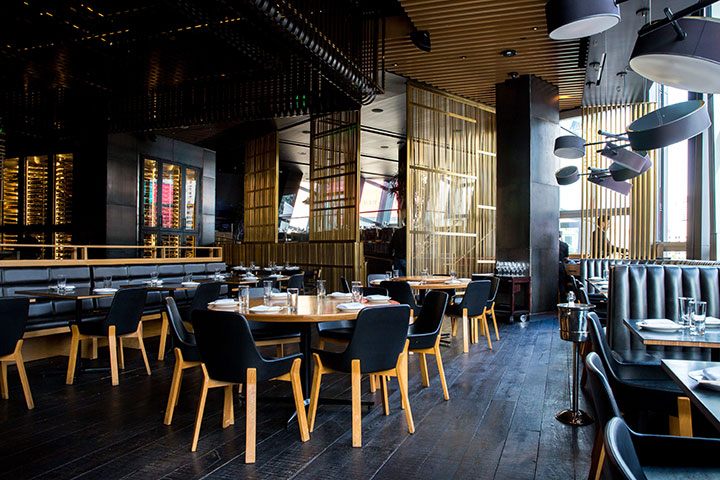
To address today’s consumer dining preferences, a number of operators are utilizing streamlined menus, multiple ordering methods and a more personalized approach—key characteristics of the NextGen Casual restaurant concept that’s gained traction in recent years.
The Smokey Bones full-service restaurant chain, for instance, plans to open its first drive-thru this year in Bowling Green, Kentucky. Customers seeking a speedy food pickup will be able to order from express menus for the main eatery and its virtual brands or a curbside menu with items that take a bit longer to prepare.
Servers are also on hand inside restaurant locations to facilitate on-premise needs, according to Smokey Bones Chief Executive Officer James O’Reilly.
“NextGen Casual dining concept consumers should expect more purpose-driven experiences,” O’Reilly says. “Doing that effectively starts with an understanding that a consumer coming in on a Wednesday at four o’clock for a quick meal has a very different set of priorities than a family who’s coming in on Saturday night at 7 p.m. for a birthday dinner.”
While adding a drive-thru or other external element is an option, significant physical renovations aren’t required to tap into the benefits NextGen Casual can provide. By incorporating one or more of the principles listed below, restaurants can broaden their appeal—and potentially their customer base—through operational and resource-based changes.
Augmented Tech Capabilities
While some operators had digital components before the pandemic, its onset made tech solutions like online ordering and contactless payment a necessity.
Consumer interest in many of those convenience elements has remained strong, even after dining rooms reopened. Nearly half of Gen Z members, for instance, and 46% of millennials would like to have the option of paying for on-premise meals with their phone, according to Datassential research on casual dining.
While takeout and delivery business likely isn’t as big a portion of restaurants’ revenue as it was two years ago, 20% of consumers are ordering delivery at least once a week, and 15% are getting takeout multiple times.
Adding designated pickup areas—something a quarter of consumers say they’d like to see—can make the takeout process easier. They can also prevent third-party delivery orders from delaying on-site customers’ service.
Targeted, Craveable Cuisine
In the past few years, Smokey Bones, which originally debuted as a barbecue-focused sports grill in the late 1990s, has worked to reposition itself, O’Reilly says, based on consumer research and testing, as a less broad concept.
The company adopted a new tagline, “Meat is What We Do,” and has rotated new protein options—such as a 2-pound Texas-style giant beef rib and 16-ounce slow-roasted pork shank—seasonally.
“We needed to simplify the menu,” he says. “Looking at culinary trends in the marketplace regarding chicken, beef and pork consumption, we realized there are millions of protein lovers; the opportunity was not to be another steakhouse [or] barbecue restaurant, but to say to consumers, ‘No one offers the range of proteins and preparation methods—smoking, fire, grilling, baking, roasting—that Smokey Bones can offer.’ That positioning has gained significant traction in the marketplace.”
During the pandemic, 48% of operators—and 36% of full-service restaurants—pared down their menu.
A smaller menu isn’t necessarily a bad thing; by NextGen standards, it can still include mouthwatering standouts that will pique consumer interest. With fewer items, operators can potentially maximize ingredient use and reduce product waste by eliminating items that were used sparingly, which could help offset the impact of continued supply chain delays and cost increases.
Some may also be able to focus on items that require less preparation time to help locations fill orders faster and free up employees to work on other tasks. With 71% of U.S. restaurant owners/operators reporting they’re losing $5,000 or more a month because of the industry’s labor shortage, making the most of your current talent resources can be a cost-effective move.
Realizing NextGen Casual’s Value Proposition
The advantages a NextGen Casual format can offer are substantial. Providing a menu that features elements like farm-to-table ingredients and buzzworthy menu items can help differentiate restaurants from the competition—which can be a central concern for operators, since consumers rate food quality and ingredients, interesting flavors, staff and service quality, and convenience as their top considerations when deciding what local restaurants to visit.
As most operators are aware, major changes can be a considerable undertaking. Completely overhauling your current approach isn’t necessary, though, to integrate NextGen Casual practices.
Restaurants of various sizes can see results from implementing an even very limited amount of NextGen Casual ideals; some may have already laid the groundwork during the past two years. If your restaurant streamlined the menu and made technological or other changes in response to pandemic-related operational needs, you may find you’re now well-positioned to build on those efforts—and make them ongoing formal policies to encourage even greater efficiency and profitability.
Hungry for more menu ideas and other insight? Sign up for the newsletter below to receive helpful operational tips and information about industry trends.


